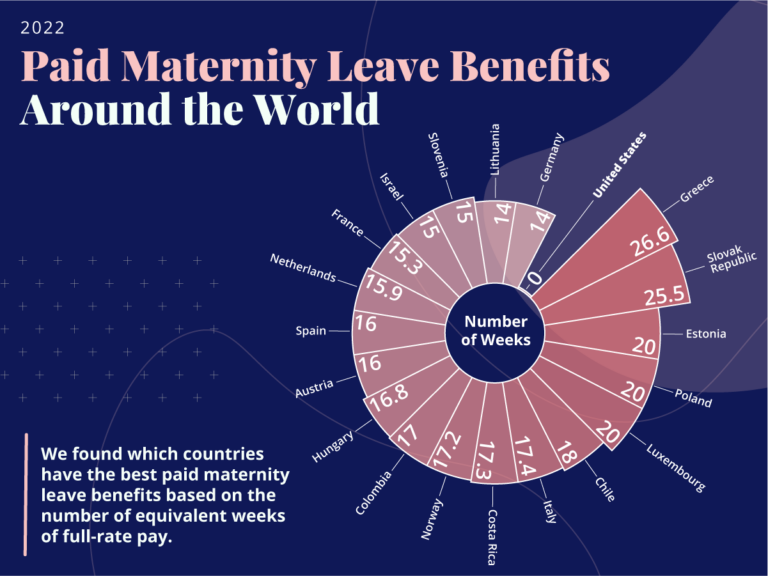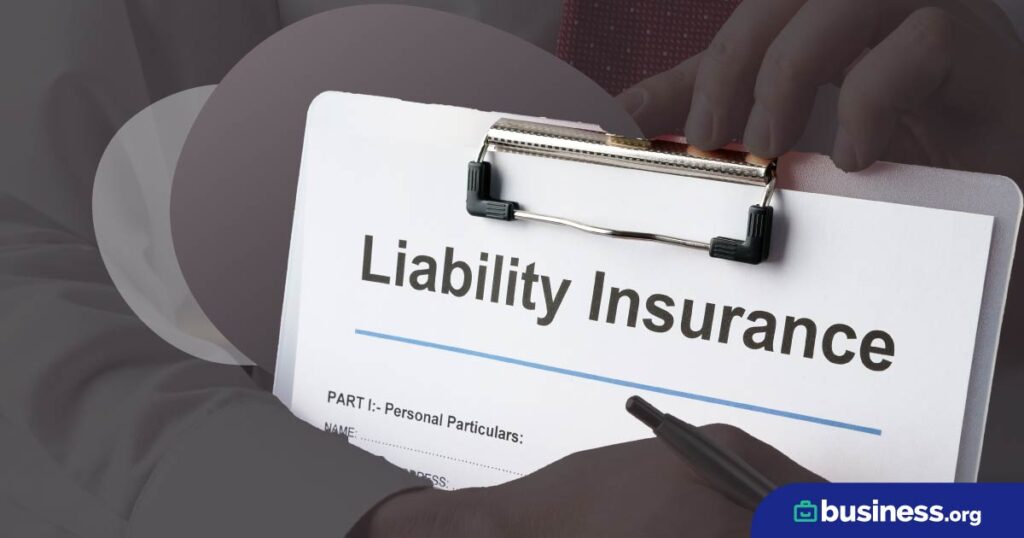We are committed to sharing unbiased reviews. Some of the links on our site are from our partners who compensate us. Read our editorial guidelines and advertising disclosure.
Paid Maternity Leave Across the World in 2022
The United States is the only country in the Organisation for Economic Co-operation and Development (OECD) to provide zero paid maternity, paternity, and parental leave.1 Any paid parental leave is either an added employer benefit or taken from the employee’s personal or sick leave. Compared to the rest of the world, the US doesn’t compete when it comes to guaranteed paid maternity leave.
Yes, the Family and Medical Leave Act (FMLA) requires eligible employees with up to 12 weeks of unpaid leave.2 But this law leaves many parents, including small-business employees, without guaranteed paid time away from work.
According to our employee benefits survey, 30% of women and 28% of men say paid parental leave is their most valued benefit. However, the BLS reports that only 23% of civilian workers had access to paid family leave as of March 2021.3
To help small-business owners better understand how to create better company benefits, we calculated the full-rate equivalent pay for maternity leave around the world. Using data available from the OECD, we found the number of weeks of paid maternity leave multiplied by the payment rate in each country.
We’ll also briefly discuss how maternity leave has changed over time and how paternity leave looks worldwide.

European countries offer the best paid maternity leave
Europe comprises most of the OECD list. However, on the western side of things, Chile, Costa Rica, and Colombia ranked in the top ten countries for maternity leave, and Mexico offers 12 weeks of fully paid maternity leave.
- A total of 13 countries (8 of which are European) offer 100% equivalent pay for maternity leave—and all of those countries offer at least 3 months equivalent pay.
- 29 countries offer at least 2 months worth of paid time. Some countries offer more time off but don’t guarantee the same amount of pay.
- Greece offers the best maternity leave globally, giving mothers 43 weeks of guaranteed maternity leave at an average payment rate of 61.8%—the full-rate equivalent of 26.6 weeks. Not far behind, Slovakia offers a full rate equivalent of 25.5 weeks over 34 weeks.
By signing up I agree to the Terms of Use and Privacy Policy.
Best countries for paid maternity leave
As you can see, the US looks vastly different from the rest of countries that offer paid maternity leave.
- Except for the US, OECD countries offer a minimum of 6 weeks (Portugal has the lowest requirement).
- The average time off (regardless of pay equivalent) across these countries is roughly 18 weeks
- The average full-rate equivalent time off is roughly 14 weeks.
- The average pay rate is 79.8%.
- Only four countries pay below 50% during maternity leave: the United States (0%), the United Kingdom (29.8%), Australia (42.4%), and Canada (47.7%).
How maternity leave around the world has changed over time
Unfortunately, maternity leave is decreasing or fluctuating in many parts of the world:
- Austria started decreasing the total amount of paid leave in 1997.
- Estonia started with 166 weeks of leave in 2012 and has since decreased to 82 weeks.
- The Netherlands decreased the leave available from 42 weeks in 2014 to 16 weeks in 2015.
- Norway’s total amount of leave fluctuates between 80 and 90 weeks.
- Sweden decreased its leave from 60 weeks in 2015 to 55.7 weeks in 2016.
How paternity leave around the world compares to the US
This year, we’ve added paid paternity leave in different countries compared to the US to give a broader picture of parental leave around the world.
Fathers have paid leave in 23 OECD countries, but not in the US. Paternity leave maxes out at the full-rate equivalent of 5 weeks.
- Portugal has 5 weeks of fully paid paternity leave available, the highest number of weeks for paternity leave.
- Austria increased leave available from 0 to 26 weeks in 1997 and then cut leave available by half to 13 weeks in 2008. It dropped to 8.7 weeks from 2010 to 2019 before jumping back to 13 weeks in 2020.
- Denmark has steadily decreased leave available to fathers since 1993, falling from 28 weeks to 15 weeks in 1994, then popping up to 17 weeks from 1998 to 2001 before falling to 2 weeks in 2002, where it remains today.
- France increased its leave available to fathers from 2 weeks in 2013 to 28 weeks in 2014.
Countries that provide paid paternity leave
Why maternity and paternity leave is important for employees and employers
Covering the pay and work of an absent employee can be stressful for employers, and parents struggle with balancing their time between work and childcare. Many mothers face potential postpartum depression, along with the other stresses of child-bearing and child-rearing.
In the long run, the benefits of paid parental leave extends to both employees and businesses, according to a 2020 report4:
- Paid leave attracts and retains talent, and improves employee health, wellness, and engagement.
- A little more than half of employers offer paid parental leave in the US (which leaves the other half of the working population uncovered); 35% of employers provide paid extended family care leave.
- Cost is the reason most employers don’t offer parental leave.
- Nearly 30% of women without paid time off dropped out of the workforce within a year after giving birth, and 1 in 5 did not return for over a decade.
- In US states with paid-leave policies, the number of female employees leaving the job after the first year of childbirth dropped by 20%. After 5 years, that number dropped by 50%.
Paid maternity leave in the US isn’t guaranteed by federal law, so employees rely on their employer to ensure they get time for doctor’s visits and bonding with a new baby—all while keeping up with the bills.
Nearly 32% of US households live on a single income, and 41% live on dual income.5 And that doesn’t account for the non-working parents who struggle to balance child care and finances on inconsistent, dependent, or no incomes.
Until we see major changes, the US remains the worst OECD country in the world for paid maternity leave.
If you’re a small-business owner who needs help with managing parental leave, payroll, and other HR-related tasks, check out our guide on the 10 Best Human Resource Software for Small Business 2022.
Methodology
Using data from the Organisation for Economic Co-operation and Development Family Database, which includes 38 countries worldwide, we determined which countries were the best for paid maternity leave.
To find which countries had the best maternity leave benefits, we ranked the number of equivalent weeks of full-rate pay. The full-rate equivalent is the number of weeks of maternity leave multiplied by the pay rate. We used the number of equivalent weeks of full-rate pay for maternity leave plus paternal leave in order to break any ties between countries.
Sources
- Organization for Economic Co-operation and Development, “OECD Family Database,” Accessed March 28, 2022.
- Department of Labor, “Family and Medical Leave (FMLA).” Accessed May 2, 2022
- Bureau of Labor Statistics, “What Data Does the BLS Publish on Family Leave?” Accessed May 2, 2022.
- SHRM, “New SHRM Research Shows Employers Offering Paid Leave Has Increased,” September 15, 2020. Accessed May 2, 2022.
- U.S Census Bureau, “Number of Earners in Family.” Accessed May 2, 2022.




